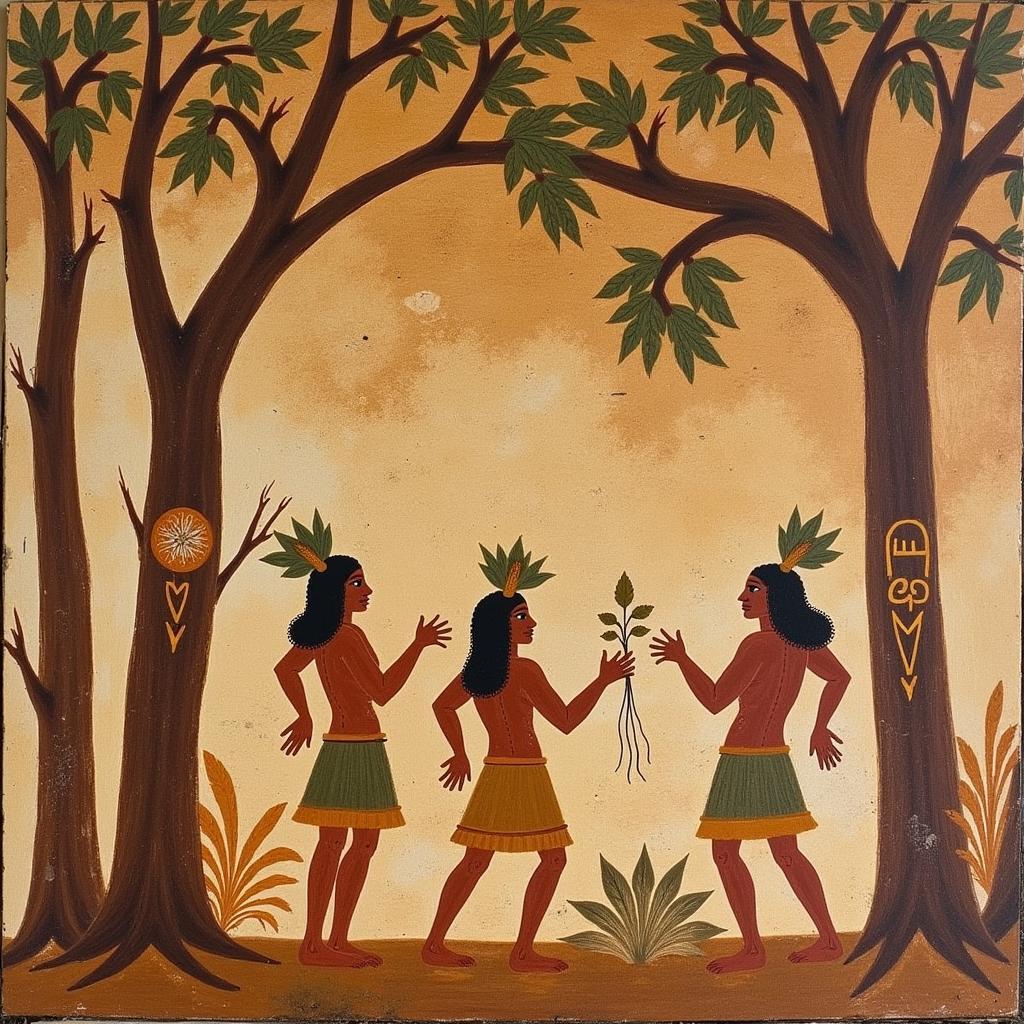Exploring the Mystical World of Sacred Grove Art
Sacred Grove Art encapsulates the spiritual connection between humans and nature, often depicting the reverence for ancient forests and the deities residing within. These artistic expressions, spanning diverse mediums and cultures, offer a glimpse into the rich tapestry of beliefs and traditions surrounding these hallowed spaces. From ancient cave paintings to contemporary digital installations, sacred grove art serves as a powerful reminder of the enduring power of nature and its profound impact on human spirituality.
Unveiling the History and Significance of Sacred Grove Art
Sacred groves, revered as dwelling places of gods and spirits, have held a special place in human history for millennia. These natural sanctuaries, often untouched by human intervention, fostered a deep sense of awe and respect, inspiring artistic creations that reflect the spiritual significance attributed to them. Early examples of sacred grove art can be found in prehistoric cave paintings, depicting animals and natural elements interwoven with symbolic representations of deities and rituals. Across different cultures, the art associated with sacred groves reveals a shared reverence for nature’s power and the interconnectedness of life.
 Ancient Cave Paintings Depicting Sacred Grove Rituals
Ancient Cave Paintings Depicting Sacred Grove Rituals
The Diverse Forms of Sacred Grove Art: From Traditional to Contemporary
Sacred grove art takes on a myriad of forms, reflecting the unique cultural expressions of different communities. From intricate wood carvings and vibrant textiles to elaborate masks and ceremonial objects, these artistic creations serve as tangible expressions of spiritual beliefs and practices. In many traditional societies, sacred grove art plays an integral role in rituals and ceremonies, connecting individuals to their ancestral heritage and the spiritual realm. Contemporary artists are also exploring new ways to interpret the concept of sacred groves, using digital media, installations, and performance art to engage with these themes in innovative and thought-provoking ways.
What are some examples of sacred grove art in different cultures?
Some examples of sacred grove art in different cultures include the intricate wood carvings of the Yoruba people in Nigeria, depicting deities associated with their sacred groves; the vibrant textiles of the Hmong people in Southeast Asia, featuring symbolic representations of nature spirits; and the elaborate masks and ceremonial objects used in rituals performed within the sacred groves of indigenous communities in the Americas.
Sacred Grove Art as a Tool for Conservation and Environmental Awareness
Beyond its spiritual and cultural significance, sacred grove art also plays a vital role in promoting environmental conservation. By highlighting the beauty and importance of these natural spaces, artists can inspire awareness and action to protect these fragile ecosystems. Many contemporary artists are using their work to address issues of deforestation, pollution, and climate change, advocating for sustainable practices and a deeper appreciation for the interconnectedness of all life. Sacred grove art serves as a powerful reminder of our responsibility to protect the natural world for future generations.
How can I learn more about sacred grove art and its significance?
You can learn more about sacred grove art by exploring ethnographic museums, attending exhibitions of indigenous art, and researching the cultural practices of communities that revere sacred groves. Books, articles, and documentaries on the subject can provide further insights into the history, symbolism, and contemporary interpretations of sacred grove art.
 Contemporary Sacred Grove Installation Promoting Environmental Awareness
Contemporary Sacred Grove Installation Promoting Environmental Awareness
“Sacred grove art is not merely a representation of nature; it’s an embodiment of the spiritual connection between humans and the environment. It’s a powerful tool for understanding our place within the web of life.” – Dr. Anya Sharma, Ethnobotanist and Art Historian
“By exploring the diverse expressions of sacred grove art, we gain insights into the rich tapestry of human beliefs and practices related to nature. It’s a testament to the enduring power of art to connect us to the spiritual and the natural worlds.” – Professor Kai Johnson, Cultural Anthropologist
In conclusion, sacred grove art offers a unique window into the spiritual and cultural significance of these hallowed natural spaces. From ancient cave paintings to contemporary installations, these artistic expressions reflect the enduring power of nature and its profound impact on human spirituality. By exploring the diverse forms and interpretations of sacred grove art, we can deepen our understanding of the interconnectedness of life and the importance of preserving these fragile ecosystems for future generations.
FAQ
- What is a sacred grove? A sacred grove is a forested area considered sacred by a particular culture or community.
- What is the significance of sacred grove art? Sacred grove art reflects the spiritual and cultural beliefs associated with these natural spaces.
- What are some common themes in sacred grove art? Common themes include deities, nature spirits, rituals, and the interconnectedness of life.
- How does sacred grove art contribute to conservation efforts? It raises awareness about the importance of protecting natural environments.
- Where can I find examples of sacred grove art? Ethnographic museums, art galleries, and cultural centers often showcase such art.
- How can I support artists who create sacred grove art? By purchasing their work, attending exhibitions, and sharing their stories.
- What are some contemporary interpretations of sacred grove art? Contemporary artists are using digital media, installations, and performance art to explore these themes in innovative ways.
Do you have other questions regarding our workshops? Visit our FAQ page for more information. You might also be interested in our article on kerala traditional art forms.
For further assistance, please contact us at Phone: 02462573573, Email: danteum@gmail.com Or visit us at: Savico Megamall, 7-9 Đ. Nguyễn Văn Linh, Gia Thụy, Long Biên, Hà Nội 10000, Việt Nam. We have a 24/7 customer support team.


